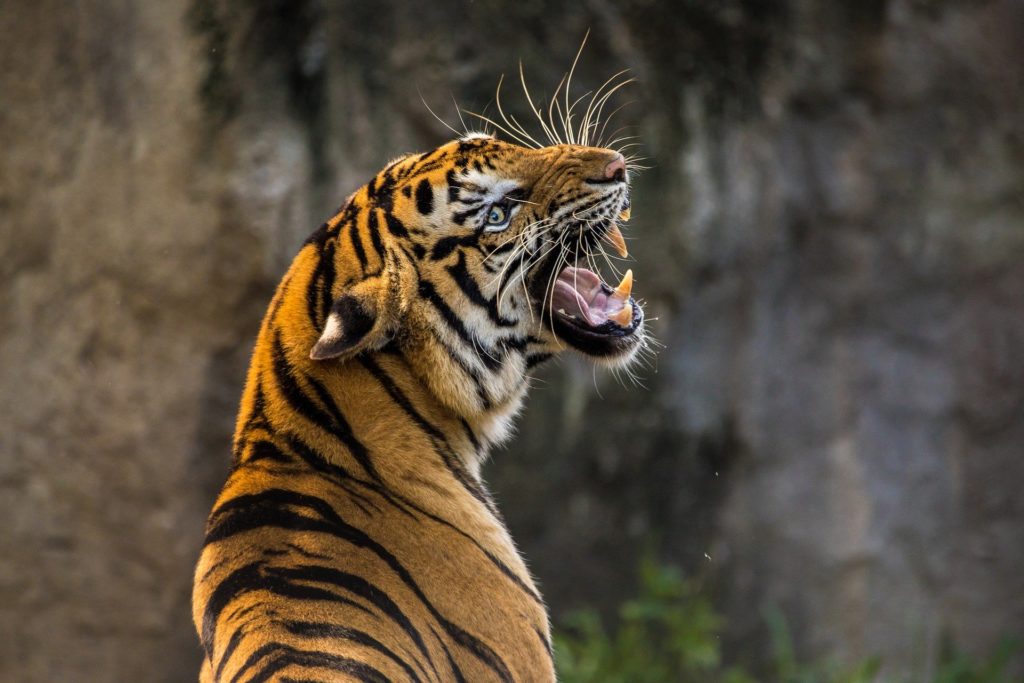How do tigers hunt?
by Scott Dutfield · 29/07/2020
These killer cats take down their prey solo, without any help from a pack

Poised between the blades of the tall grass in the savanna, a feline body is crouched like a coiled spring, ready to pounce on a passing deer. Within seconds this striped assassin leaps from its grassy hideout, delivering a fatal blow to the back of the deer’s neck before feasting on its victim’s flesh.
Tigers are notorious stalkers, a technique that has served them well in the wild. Typically tigers make a kill once a week, and they have the ability to consume up to 40 kilograms of food in a single sitting. With a diet almost exclusively made up of meat, they have fine-tuned hunting skills, placing them at the top of the food chain as an apex predator.
Tigers will tentatively stalk their future meal until they’re within six to nine metres away. Once in range, tigers target their prey’s neck, which severs its spinal cord. Larger meals may also require a fatal bite to the throat to drag them to the ground. As capable swimmers, tigers also utilise surrounding water to drag down and drown resistant prey. Once the struggle is over, tigers will move their catch under cover to enjoy in peace without interference from scavengers.
Usually hunting at night, tigers possess excellent eyesight – six times that of a human’s night vision. Unlike their lion cousins, adult tigers do not hunt as a collective pride, preferring to hunt solo. Though this may reduce the likelihood of a kill, the meaty rewards are reserved solely for the hunter.
Hunting school
Tigers are not born with the exact knowledge of how to expertly take down fleeing food – that lesson is learnt from their mother. At the beginning of a tiger’s life, cubs feed on their mother’s milk, before moving onto the meat she catches. Once the cubs are around eight to ten months old they will start to hunt with their mother, spending the next year or two learning how to hunt from her example. The mother will play with her cubs in order to teach her offspring useful life skills like pouncing and stalking. She will take her cubs on hunting expeditions to showcase how a kill is made, in the hope that the cubs will mimic her technique. Once their training is complete, the next generation of hunters will leave their mother’s side and seek their own territories in which to hunt for prey.
Hunting in captivity
With more tigers living in captivity than in the wild (up to 7,000 in the US alone, compared to around 3,890 wild individuals worldwide), zookeepers have come up with different ways to satisfy tigers’ desire to hunt. As introducing live prey into enclosures is strictly prohibited, zookeepers aim to mimic aspects of prey by artificial means. The Smithsonian’s National Zoo in Washington, US, has a novel approach to allowing the resident tigers to display their predatory behaviour. Large, sturdy balls known as ‘boomer balls’ are used for tigers and other big cats to chase and interact with like live prey. Other methods of hunting enrichment include animating animal carcasses or creating prey species out of cardboard for tigers to stalk and hunt.
This article was originally published in How It Works issue 123
For more science and technology articles, pick up the latest copy of How It Works from all good retailers or from our website now. If you have a tablet or smartphone, you can also download the digital version onto your iOS or Android device. To make sure you never miss an issue of How It Works magazine, subscribe today!





